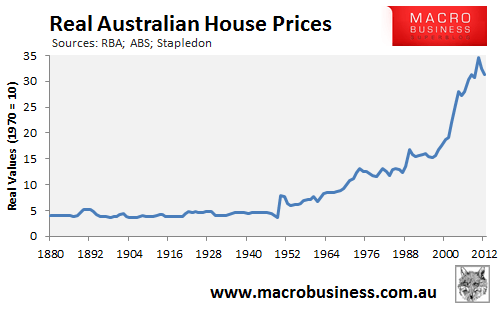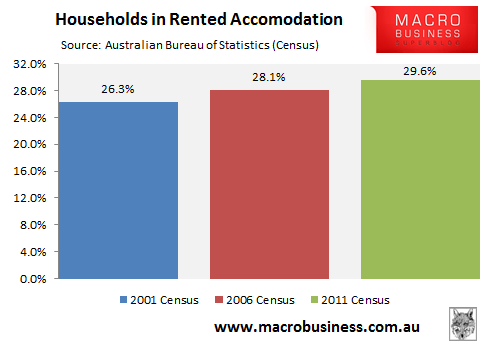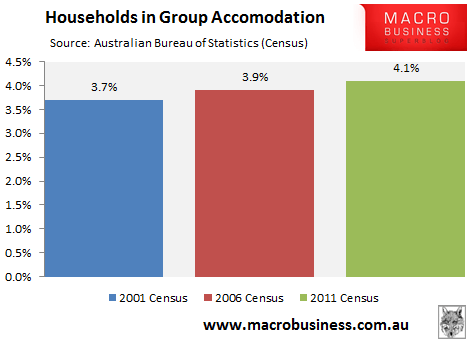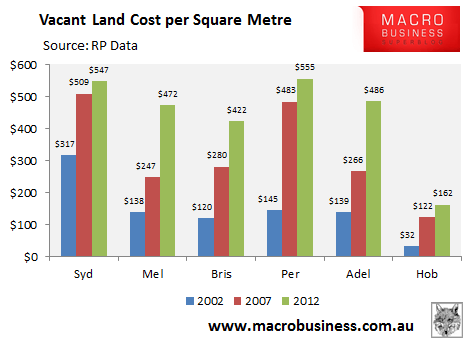
Catherine Cashmore published an interesting article yesterday at Property Observer questioning whether house prices in Australia can forever out-pace inflation:
…we’re reaching that time of year where real estate pundits will dust off the crystal ball and make some future predictions into 2013 – not that we haven’t had a fair few already. Out will come the property clocks, and we’ll get a lesson in how to tell the house market time in order to assess exactly when “the right time to buy or sell” is…
The trouble with the housing market is that we have had a decade-long boom in growth, during which median prices in many areas of Australia have more than doubled in nominal terms…
It could be argued that even with a slight uplift in the number of seasonal transactions as we approach the end of 2012, a larger population of buyers have determined that the cost of housing is still too high and further corrections to market prices need to be in evidence before they read the property clock as a call to dust off the cheque book and head back out into the housing market terrain.
As if to underline how unaffordable housing is deemed to be on a historical time scale, households are no longer decreasing in size, children are leaving it later to leave the nest and the increase in the number of people sharing accommodation has accelerated…
For investors, housing has long been viewed as a hedge against inflation. Since the mid-1990s to the peak in 2010 Australia’s housing market has enjoyed long periods during which prices have far exceeded the rate of inflation. However, as shown by some of the oldest housing indexes in the world, house prices that consistently exceed the rate of inflation typically undergo a period of “correction” and remain the same in real terms when viewed over the longer trajectory…
Opponents to any forthcoming on the horizon Australian property crash cite our strong population growth, limits on land supply as well as good long-term credit, wage growth and somewhat disputable “well-regulated” lending practices as placing a floor beneath prices – and thus far, this has indeed been the case.
However, the post-1950s US market was also considered stable – with Richard Peak from the Federal Reserve Bank of New York confirming back in 2005 that “(house) prices are in line with economic conditions”. Two years later, and his assumptions were starting to show cracks.
Throughout every period of history, it’s been the norm to assume a rosy outlook and the exact timing of any significant or sudden fall in property prices has rarely been predicted with outstanding accuracy.
As I said above, its human behaviour that dictates cycles and on paper figures aside, it is abundantly clear from the low level of transactions throughout the year and reluctance to take on debt that our home buying psychology – at the very least – has changed.
At the moment, most analysts are pointing towards an improvement in the housing market as we enter 2013 and thus far, this seems to be a fair proposition – however considering the current instability with job losses and some of our larger companies going into receivership, along with continued instability overseas in both Europe and the Middle East, and the RBA describing some of its previous forecasts as no better than a ‘random walk in the park’, there are certainly no guarantees.
There is, however, plenty of solid evidence to show our housing market is unaffordable for a growing populous of young buyers, and crashes, bubbles and long-term housing indexes aside, the RBA, Treasury, and both state and federal governments should be concentrating on keeping prices stable for an extended period of time, rather than placing us back in a low interest rate, incentive driven inflationary environment.
With 2013 in sight and an expected continuation of somewhat tenuous economic conditions, the long-term health of our housing market cannot be sustained unless we seriously address the issues that have pushed house prices out of reach for a growing minority.
While I agree with the thrust of Cashmore’s article, and am a big believer in mean reversion when it comes to asset prices, I don’t believe that house prices, in the long-run, should only track the rate of inflation. Rather, they should grow in line with nominal incomes, which tend to grow above the rate of inflation. Nevertheless, the latest house price boom, which roughly commenced in 1996 and ended in 2010, was unprecedented, with Australian house prices increasing by over 120% in real (inflation-adjusted) terms over that period (see below chart).

While prices have fallen by around -10% since peak in real terms, it’s fair to say that valuations remain stretched and further real price deflation is required to bring values back in line with fundamentals, such as incomes and GDP.
Second, Cashmore is correct to point-out the sharp decline in housing affordability (despite lower nominal mortgage rates) for many members of society. The 2001, 2006 and 2011 Census’ revealed a steady increase in the proportion of households in rented accommodation as well as group homes (see below charts), to go along with the recent increase in household size as well as the increasing age of first home buyers.


Third, while I agree that “the RBA, Treasury, and both state and federal governments should be concentrating on keeping prices stable for an extended period of time, rather than placing us back in a low interest rate, incentive driven inflationary environment”, they are caught in a pincer. Those authorities have openly stated that housing construction needs to increase to fill the void left as the mining boom unwinds. However, with fringe land prices currently at astronomical levels (see below chart), the cost of new housing is beyond what many home buyers are able or willing to pay. Accordingly, interest rates will need to be lowered significantly in order to both make housing more affordable and to inflate the cost of pre-existing housing, thereby making new homes relatively more desirable.

Ultimately, the answer to housing affordability lies in bringing down land prices, which predominantly requires reforms to restrictive state government planning policies as well as improvements in infrastructure provision and financing, supplemented by taxation reforms such as the winding-back of negative gearing rules and the implementation of broad-based land taxes (in place of transaction taxes like stamp duties).
Twitter: Leith van Onselen. Leith is the Chief Economist of Macro Investor, Australia’s independent investment newsletter covering trades, stocks, property and yield. Click for a free 21 day trial.

